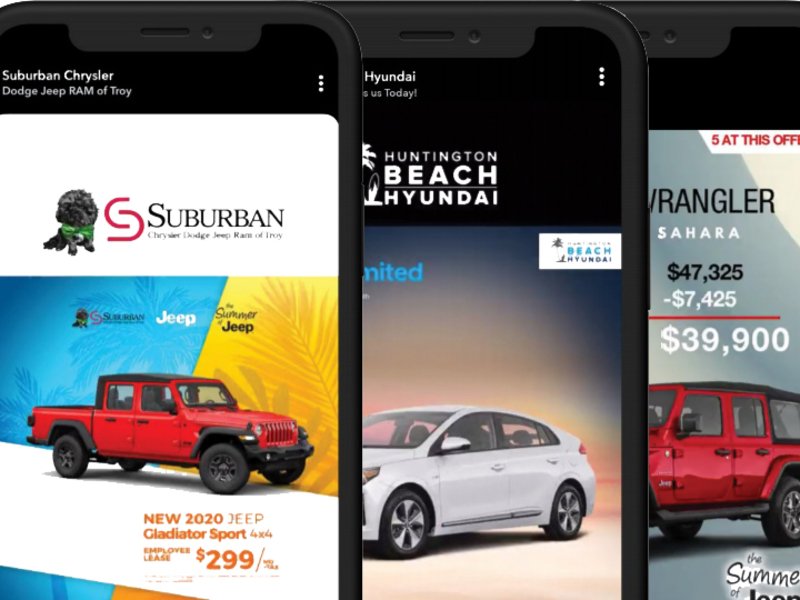
Huntington Beach Chrysler-Dodge-Jeep-Ram wanted to make waves when the U.S. Open of Surfing came to town last summer.
The Southern California dealership’s ad team, TurnKey Marketing, decided to get in on the action via Snapchat, the growing messaging app that has a foothold among the industry’s youngest customers.
TurnKey used Snapchat’s filter tool, which allows advertisers to create overlays that people can put on photos that they then share with friends and followers, to engage with attendees of the surfing spectacle on behalf of the dealership.
The Huntington Beach dealership’s filter caught on. It was used around 7,400 times and drew 200,000 views, TurnKey co-founder Drake Baerresen said. The cost to the dealership was just $700.
Baerresen said TurnKey also uses quick-hit advertisements on the Snapchat app to target certain shopper segments and gauge their responses. Baerresen said his agency can track phone calls and walk-in traffic back to the ads.
“We have all these tracking tools and pixel setups to see when these people come back and what their actions are,” Baerresen told Automotive News. “And what we found with Snapchat is most people, after seeing the ad, take action to that exact dealership within 72 hours. That’s either showing up, calling or visiting the website.”
Young consumers have been heading to Snapchat for years as their parents and grandparents set up shop on Facebook. The platform, which claims to reach 75 percent of millennials and members of Generation Z in the U.S., gives automakers and dealers another social media puzzle to figure out in their quest to expand their customer base.
Snap Inc., the creator of the app, has added solutions on the platform to make it more conducive to auto marketers while also dishing out advice on how to best reach consumers. It released an auto playbook for dealers in November that breaks down its various ad units and discusses best practices.
For instance, the playbook shows how dealers can pitch products and offer the option to “swipe to text” the store.
“Dealers are starting to lean into the platform to really try to drive efficient site actions and try to drive consumers to engage with vehicle inventory within their websites,” Shane Dwyer, Snap Inc.’s senior manager of advertiser solutions, said.
Internal data from Snap Inc. says 28 percent of Snapchat users reported being in the market for a vehicle in the next 12 months. According to the company, the app reaches 20.2 million new- and used-car shoppers every month in the U.S.
A 2019 Snapchat survey found that among users ages 18 to 24 with driver’s licenses, 84 percent have a new or used vehicle.
Of those, 43 percent purchased their vehicle with their own funds. For Snapchatters with a license who are 25 and up, 94 percent have a new or used vehicle.
Overall, 90 percent of adult Snapchatters with a license have a vehicle, the survey found.
Automakers including BMW USA, Ford Motor Co. and Toyota Motor North America have turned to the app.
Toyota partnered with Snapchat last year on two Corolla campaigns. For the Corolla hatchback, the automaker said it delivered an augmented reality experience “which allowed the user to explore our vehicle up close and personal, as well as a ‘surprise and delight’ moment, which changed the world around the user.” A driving game experience highlighted key features of the Corolla sedan.
Ford Canada used Snapchat’s augmented reality tool to promote the EcoSport crossover. In addition to a virtual walkaround, Ford gave users the ability to see the interior as if they were inside the vehicle.
BMW has gone the augmented reality route as well, placing a 3D version of the X2 crossover in front of users when they peered through their phones.
Users could do a virtual walkaround, change the color and get an up-close look before it hit showrooms.
Nancy Inouye, national media manager for Toyota Motor North America, said Snapchat has listened to Toyota’s specific needs for its campaigns and collaborated with the automaker to develop solutions.
“With Snapchat, it’s important for us to lean into the unique nature of the platform, its users’ behaviors, and the platform’s unique ad offerings,” Inouye said in an email. “We can leverage Snapchat’s capabilities to tell stories that allow for deeper engagement and interaction among an audience that may be hard to reach elsewhere.”
She added: “It will be interesting to track the Snapchat platform as they continue to roll out ad units more catered to automotive brands that allow for more in-depth exploration of vehicle products in the auto consumer journey.”